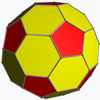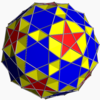| Small snub icosicosidodecahedron | |
|---|---|

| |
| Type | Uniform star polyhedron |
| Elements | F = 112, E = 180 V = 60 (χ = −8) |
| Faces by sides | (40+60){3}+12{5/2} |
| Coxeter diagram | |
| Wythoff symbol | | 5/2 3 3 |
| Symmetry group | Ih, , *532 |
| Index references | U32, C41, W110 |
| Dual polyhedron | Small hexagonal hexecontahedron |
| Vertex figure |  3.5/2 |
| Bowers acronym | Seside |

In geometry, the small snub icosicosidodecahedron or snub disicosidodecahedron is a uniform star polyhedron, indexed as U32. It has 112 faces (100 triangles and 12 pentagrams), 180 edges, and 60 vertices. Its stellation core is a truncated pentakis dodecahedron. It also called a holosnub icosahedron, ß{3,5}.
The 40 non-snub triangular faces form 20 coplanar pairs, forming star hexagons that are not quite regular. Unlike most snub polyhedra, it has reflection symmetries.
Convex hull
Its convex hull is a nonuniform truncated icosahedron.
 Truncated icosahedron (regular faces) |
 Convex hull (isogonal hexagons) |
 Small snub icosicosidodecahedron |
Cartesian coordinates
Let be largest (least negative) zero of the polynomial , where is the golden ratio. Let the point be given by
- .
Let the matrix be given by
- .
is the rotation around the axis by an angle of , counterclockwise. Let the linear transformations be the transformations which send a point to the even permutations of with an even number of minus signs. The transformations constitute the group of rotational symmetries of a regular tetrahedron. The transformations , constitute the group of rotational symmetries of a regular icosahedron. Then the 60 points are the vertices of a small snub icosicosidodecahedron. The edge length equals , the circumradius equals , and the midradius equals .
For a small snub icosicosidodecahedron whose edge length is 1, the circumradius is
Its midradius is
The other zero of plays a similar role in the description of the small retrosnub icosicosidodecahedron.
See also
External links
- Weisstein, Eric W. "Small snub icosicosidodecahedron". MathWorld.
- Klitzing, Richard. "3D star small snub icosicosidodecahedron".
This polyhedron-related article is a stub. You can help Misplaced Pages by expanding it. |
 be largest (least negative) zero of the polynomial
be largest (least negative) zero of the polynomial  , where
, where  is the
is the  be given by
be given by
 .
. be given by
be given by
 .
. by an angle of
by an angle of  , counterclockwise. Let the linear transformations
, counterclockwise. Let the linear transformations  be the transformations which send a point
be the transformations which send a point  to the
to the  with an even number of minus signs.
The transformations
with an even number of minus signs.
The transformations  constitute the group of rotational symmetries of a
constitute the group of rotational symmetries of a 
 ,
,  constitute the group of rotational symmetries of a
constitute the group of rotational symmetries of a  are the vertices of a small snub icosicosidodecahedron. The edge length equals
are the vertices of a small snub icosicosidodecahedron. The edge length equals  , the circumradius equals
, the circumradius equals  , and the midradius equals
, and the midradius equals  .
.


 plays a similar role in the description of the
plays a similar role in the description of the